Saint Kitts and Nevis
Travel Guide Caribbean Saint Kitts and Nevis
Introduction
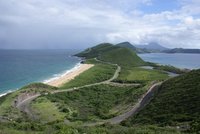
Atlantic Ocean left, Caribbean Sea right
© Utrecht
The islands of Saint Kitts and Nevis, also known as Saint Christopher and Nevis, are an undiscovered duo of supreme beauty and languidness, where the main tourist activity is gawking. Being forced to just enjoy nature as it is makes a Saint Kitts and Nevis holiday a profoundly moving experience.
Both islands are characterized by amazing tall peaks: Nevis Peak, once thought to be snow-covered; and Mount Liamuiga, on Saint Kitts, a dormant volcano who seems to have opted to sleep his days away and let rainforest cover his slopes. Hiking expeditions to these peaks can be arranged, but should be done with a guide. While winding through lush rainforest adorned with bright flowers and monkeys, the hassle of getting a guide will be well worth it. Saint Kitts and Nevis possess a compelling array of natural variety, beauty and colour.
Brief History
Five thousand years prior to European arrival, the island was settled by Native Americans. The latest arrivals, the Kalinago peoples, arrived approximately 3 centuries before the Europeans. The Kalinago allowed the Europeans to colonise Saint Kitts, while earlier attempts to settle other islands were met with immediate destruction of the colonies by the Indians. The Kalinago were eventually wiped out in the great Kalinago Genocide of 1626.
The islands of Saint Kitts and Nevis are two of the Caribbean's oldest colonised territories. Saint Kitts became the first British colony in the West Indies in 1624 and then became the first French colony in the Caribbean in 1625, when both nations decided to partition the island. The island of Nevis was colonised in 1628 by British settlers from Saint Kitts. From there, Saint Kitts became the premier base for British and French expansion, as the islands of Antigua, Montserrat, Anguilla and Tortola for the British, and Martinique, the Guadeloupe archipelago and St. Barths for the French were colonised from it.
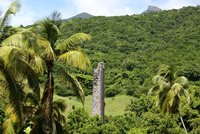
St Kitts scenery
© Utrecht
Although small in size, and separated by only 3 kilometres of water, the two islands were viewed and governed as different states until the late 19th century, when they were forcibly unified along with the island of Anguilla by the British. To this day relations are strained, with Nevis accusing Saint Kitts of neglecting its needs.
Saint Kitts and Nevis, along with Anguilla, became an associated state with full internal autonomy in 1967. Anguillians rebelled, and their island was allowed to separate from the others in 1971. St. Kitts and Nevis achieved independence in 1983. It is the newest sovereign nation in the Americas. In August 1998, a vote in Nevis on a referendum to separate from St. Kitts fell short of the two-thirds majority needed. In late September 1998, Hurricane Georges caused extreme damage. [1]
Geography
Saint Kitts and Nevis is a twin island country with a total landmass of just 270 km2. The island of St. Kitts, the larger of the two, is 180 km2 in size and is located at latitude 17.30 N, and longitude 62.80 W. Nevis is 93 km2 and located at latitude 17.10 N, longitude 62.35 W, approximately 3 kilometres southeast of St. Kitts. They are about one-third of the way from Puerto Rico to Trinidad and Tobago. Mount Liamuiga on St Kitts is the highest point at 1,156 metres above sea level. Much of the islands are covered in tropical forests, especially at higher elevations, though large areas have been reserved for towns, agriculture and tourism as well.
Regions
The islands of Saint Kitts and Nevis is divided into 14 parishes.
- Saint Kitts: Christ Church Nichola Town, Saint Anne Sandy Point, Saint George Basseterre, Saint John Capesterre, Saint Mary Cayon, Saint Paul Capesterre, Saint Peter Basseterre, Saint Thomas Middle Island, Trinity Palmetto Point.
- Nevis: Saint George Gingerland, Saint James Windward, Saint John Figtree, Saint Paul Charlestown, Saint Thomas Lowland.
Cities and Towns
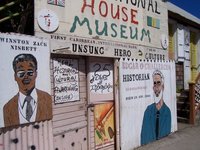
Museum in Basseterre
© Utrecht
- Basseterre - The capital of the federation and of Saint Kitts.
- Cayon
- Charlestown - The capital of Nevis.
- Gingerland - The largest town on Nevis.
- Sandy Point Town - The second largest town in the country.
Sights and Activities
Horse riding
Horse riding is an activity you can undertake almost anywhere in the world, but on the island of Nevis it is a bit different. Most trips include long rides along the beaches, passing beautiful white sands, turquoise waters and hanging palm trees. Visit the Ride Nevis website for more details about tours, prices and itineraries.
Brimstone Hill Fortress National Park
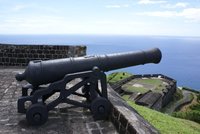
Brimstone Hill Fortress
© Utrecht
The compound known as Brimstone Hill Fortress National Park dates back to the 18th century and was known as the 'Gibraltar of the West Indies' as it was once a major British garrison until it was abandoned in 1850. Since the 1960's there have been restorations and as a result much of the fortress has been returned to how it looked like before. It was designed by the British and built by African slave labour and the fortress is a testimony to European colonial expansion, the African slave trade and the emergence of new societies in the Caribbean and therefore is placed on the Unesco World Heritage List.
The Citadel on the main hilltop has 24 cannons and provides excellent views of Sint Eustatius and Sandy Point Town. Inside are old rooms displaying colonial history featuring cannonballs and swords Brimstone Hill itself is a volcanic cone named for the sulfur vents that you will undoubtly smell as you drive past the hill along the coastal road. For more information check the Brimstone Hill Fortress website for details.
Nevis botanical gardens
The Nevis botanical gardens cover about 3.2 hectares of land only and are only a few minutes' southeast of Charlestown. The gardens display a rare and stunning collection of tropical greenery, orchid and rose gardens, and a rainforest conservatory. All flora is marked with its common name, making it accessible to all. There are some fine giftshops and restaurants nearby as well. Visit the Nevis Botanical Gardens website for more information.
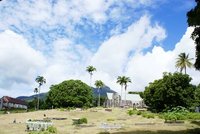
Local cemetery
© Utrecht
Other sights and activities
- Kitesurfing - Saint Kitts and Nevis are one of the best kitesurfing spots in the Caribbean
- Black Rock - a collection of black lava rocks on the western coastline of Saint Kitts
- The museums. There are three museums on Nevis: the Nelson Museum, the Alexander Hamilton House (home to the Nevis Historical and Conservation Society), and the Sports Museum. There is also the Philatelic Bureau, of interest to stamp collectors.
- Hermitage Plantation in Saint John, has one building that was built of lignum vitae wood in 1640; this is the oldest surviving wooden house still in use in the Caribbean today.
- Bath Hotel of 1778. Located just outside Charlestown, this was the first hotel built in the Caribbean and may even be said to have started tourism in the Americas; it was a luxury hotel and spa. The soothing waters of the hotel's hot springs lured many famous Europeans, including the poet Samuel Taylor Coleridge, Antigua-based Vice Admiral Horatio Lord Nelson and Prince William Henry, Duke of Clarence, the future William IV of the United Kingdom. These luminaries attended balls and private parties at the hotel. The hotel's time of splendiferous entertainment and revelry collapsed with the sugar industry in the 19th century, and the original structure suffered damage in a 1950 earthquake. However, in recent years the building has been repaired and restored, and now serves as government offices. Open-air access to the volcanic hot-spring water is available to anyone without charge, and in 2013 a channel was built to allow people to access pools of the volcanic water when it is less than extremely hot, as it is when it first emerges from the spring. Free.
- Historical churches - Many of the churches on Nevis also date to the 18th century, as well as some of the reconstructed mills.
- Ruins. Architecture from the past includes historical estate buildings and sugar mills. Popular destinations with ruins worth viewing include Hamilton Estate, New River Estate, Coconut Walk Estate, The Lime Kiln, and Cottle Church.
Events and Festivals
Battle of St Kitts reenactment
Held annually on March 28, this takes place over three days at Brimstone Hill Fort. History comes alive as the famous battle between British and French forces in 1782 is reenacted here. It is a great spectacle that allows you to imagine this aspect of colonial life in the 18th century. The real battle actually took place on January 25th and 26th but the modern reenactment takes place in March.
St Kitts Music Festival
An internationally acclaimed music festival held over the last weekend of June each year. It has been running for 16 years, and now many international artists come to perform at the festival, playing pop, jazz, and reggae, amongst other styles. There is no onsite accommodation at the festival, so visitors usually stay in nearby hotels. Tickets for the festival can sell out months before, so it is worth purchasing early on if you intend on going.
Culturama
This is the smaller island of Nevis’ answer to the main annual festival held in St Kitts. It is held over the last weekend of July, and features similar music, street dancing, parades, and pageants.
Independence Day
Independence Day is a public holiday that celebrates the independence and formation of the sovereign nation of St Kitts and Nevis. During the week either side of the day communities have a schedule of events including parades, picnics, and formal cocktail receptions.
Latin Fiesta
This is a more recent addition to the annual festival calendar, and is growing in popularity. Held over the last weekend in October, the festival showcases Latin culture through film, music, and dancing. Some events are free to join.
St Kitts Carnival
A fun festival held from the middle of December until early January each year, with lively events happening over the Christmas period. For example, a major highlight of the festival is “J’ouvert morning,” whereby steel and brass bands parade through the streets playing music that many people dance to. The music goes well into the early hours of the morning. It is an extremely lively festival, and the basis is to celebrate St Kitts and Nevis’ proud Caribbean culture.
Weather
Saint Kitts and Nevis have a warm and humid tropical climate with temperatures usually around 30 °C during the day and around 23 °C at night. June to September is slightly warmer with temperatures above 30 °C at daytime and not dropping below 26 °C on average at night. Rainfall is spread throughout the year and possible in every month but July to November is the wetter time of year while February to May is somewhat drier.
Getting There
Being an island nation, the only way to get to Saint Kitts and Nevis will be by plane or by boat. Still, there are no regular ferries to and from the islands, although there has been some rumors about boats to and from Sint Eustatius, one of the Netherlands Antilles.
By Plane
Robert L. Bradshaw International Airport (SKB) is on Saint Kitts. Windward Islands Airways (Winair) flies there from Nevis and Saint Martin while Leeward Islands Air Transport flies to and from Antigua and Barbuda and St. Thomas. Connections to North America and Europe include Miami and New York by American Airlines, and London by British Airways. There are also seasonal flights to Toronto and flights to Charlotte and Philadelphia.
Vance W. Amory International Airport (NEV) is on Nevis with Winair flying to Saint Kitts and Saint Martin, LIAT to Antigua and Barbuda, while American Eagle has flights to and from San Juan, Puerto Rico.
By Boat
There are no regular boats serving the islands, though once every week or two there are boats between Basseterre on Saint Kitts and Philipsburg in Sint Maarten. Mainly locals go shopping for the weekend as the ferry returns the other day again. You might also be able to find a fisherman who will bring you from for example Sint Eustatius but don't count on it.
Getting around
By Plane
Windward Islands Airways (Winair) operates flights between the two islands.
By Train
St. Kitts Scenic Railway operates a scenic tour on the island of Saint Kitts on an old railway track formerly used by sugarcane plantations. This tour runs on a 48-kilometre (30-mile) loop and takes about 3 hours to complete.
By Car
Renting a car is a good way to explore the islands, although not necessary. Taxis drivers will be glad to show you much of the island on a tour as well for a fixed price. If you do feel the need to have your own wheels, many of the international (hertz, avis) and local companies offer rental cars for reasonable prices. You can see much of Saint Kitts in a day or two and you will only need a day in Nevis.
By Bus
Bus travel is a good and cheap way to get around the islands and most trips don't cost more than a few Eastern Caribbean Dollars (EC$). Buses can be flagged down anywhere along its route and also stop anywhere along its route to drop passengers.
Saint Kitts
On the main island of Saint Kitts, there are 5 bus routes which all originate and terminate at the capital Basseterre. They are:
- Basseterre to Sandy Point travelling west, starting at the Ferry Terminal
- Basseterre to Capesterre travelling west, starting at the Ferry Terminal
- Basseterre to St. Peter's travelling north, starting at College Street Ghaut
- Basseterre to Molyneux travelling east, starting at Baker's Corner
- Basseterre to Saddler's travelling east, starting at Baker's Corner.
Nevis
On the smaller island of Nevis there are two bus routes who both travel around the ring road of the island. Both routes orginate and terminate in the capital Charlestown.
Buses traveling north from Charlestown leave from the southwest end of D.R. Walwyn Plaza and buses traveling south from Charlestown leave from the northern end of Memorial Square.
By Boat
Six ferries operate between the islands of Saint Kitss and Nevis: the MV Caribe Queen, MV Carib Breeze and MV Carib Surf, the MV Mark Twain, the MV Geronimo and the MV Sea Hustler. The MV Mark Twain is currently inactive, but the other 5 vessels have a total of 15 sailings a day between both islands in either direction, between 6:30am (first sailing from Saint Kitts) to 7pm (last sailing from Saint Kitts). From Nevis, the first one leaves at 7:00am and the last at 6:00pm. Crossings take about 45 minutes and provide an excellent way of travelling between the capital Basseterre on Saint Kitts and Charlestown, the 'capital' of Nevis.
Red Tape
Citizens of Commonwealth countries, Organization of American States (except the Dominican Republic), Puerto Rico, US Virgin Islands and the following countries do not require visas: Austria, Bahrain, Belgium, Denmark, Egypt, Finland, France, Germany, Greece, Iceland, Ireland, Israel, Italy, Jordan, South Korea, Kuwait, Liechtenstein, Monaco, Kingdom of the Netherlands (incl. Aruba, Bonaire, Curaçao, Saba, Sint Eustatius, and Sint Maarten in addition to the Netherlands in Europe), Norway, Oman, Qatar, Saudi Arabia, Spain, Sweden, Taiwan, Turkey, UK and the United Arab Emirates.
Visa applications must be mailed to the Embassy in Washington, D.C. Included in your submission should be the original completed application form (you cannot copy the form and send it), your passport (valid for at least 6 months after visiting Saint Kitts and Nevis, 2 passport-size photographs and the visa fee ($50). You must also include the mailing fee. The normal fee is $5, but if you want express overnight postage, the fee is $15.75.
Money
See also Money Matters
The currency of Saint Kitts and Nevis is the Eastern Caribbean Dollar, or EC$. It has existed since 1965 and is used by 7 other states of the Organisation of Eastern Caribbean States as well. Only the British Virgin Islands (the nineth member) doesn't use it, but uses the US$ instead. The EC$ is subdivided into 100 cents and has been pegged to the United States dollar at US$1 = EC$2.7 since 1976. The EC$ comes in coins of 1, 2, 5, 10 and 25 cents and a coins of 1 dollar. There are notes of 5, 10, 20, 50 and 100 dollar.
Language
The language of Saint Kitts and Nevis is English. However if you have never visited the Caribbean before you may have difficulty understanding the patois, or more correctly the Creole language, spoken by the locals which is based on the English language but to the untrained ear sounds nothing like it. For example "a-come" means coming "a-knock" means knocking. Most notable is the simplification of use of pronouns as in "I and I" which replaces all other pronouns like she/he, we/my, yours, hers/his and ours. The Caribbean patois has its roots not only in African languages (west, central and Nigerian), standard English, Scottish and Spanish but also Perso-Arabic and Sanskrit. Unusually the end result is not just a language but also a philosophical statement which emphasises the group relationship rather than the personal.
Eat
There are many dining options in St. Kitts. A number of restaurants are located in Frigate Bay. Mr. X's Shiggity Shack, Cathy's, Patsy's, Boozies and Vibes Beach Bar on South Frigate Bay beach are more traditional, casual beach bar restaurants. On the opposite side, on North Frigate Bay, there are several western-style restaurants, including Ciao (Italian), Rock Lobster (seafood, mixed American and Caribbean) and PJ's (American, delicious pasta). South Friars is home to Godfather's, Jam Rock, Carambola Beach Club and Shipwreck Beach Bar. Cockleshell is home to Lion's Beach Bar, Spice Mill and Reggae Beach Bar.
Around the island there is also the Royal Palm at Ottley's Plantation (upscale), Sprat Net (casual, seafood) and Nirvana Restaurant. In Basseterre you will find Circus Grill, Ballahoo, and in Fortlands there is Serendipity (upscale) and Ocean Terrace Inn's Fisherman's Wharf.
Nevis food is a blend of European, American, with hints of African and Asian. Some local delicacies which may be features in meals are breadfruit, coconut jelly, fresh mangos, and fresh tamarind. It is nearly impossible to get a bad meal on Nevis. The food is fresh and further complimented by the island's lack of pollution. The simple but delicious (and widely available) roti is a roll-up with a savoury filling. Restaurants serve breakfast, lunch, and dinner, and are usually closed in between these times. Restaurants also close early at night, so expect to eat dinner before nine or ten, or not at all.
There is a surprisingly wide range of different places to eat, including quite a few Chinese restaurants, and a well-regarded Indian Restaurant called "Indian Summer". Not all restaurants on Nevis look grand, but do not let this sway your decision on where to eat, as very often the food is really good even in the simplest places. The local bars and grills are in the lower price range, and feature a lot of Nevis's culture. There are also many moderately priced food venues. The highest-priced restaurants are mostly located at the hotels.
You may want to try:
- Riviere House uphill a little on the edge of Charlestown - a very elegant, cool breezy setting, and very good food, not expensive.
- Chrishi Beach Club at the south end of Cades Bay, not far from the Sea Bridge ferry stop - really excellent food.
- Nature's Way not far from Ram's supermarket - very good vegetarian food at excellent prices, no alcoholic drinks served.
Sleep
Both islands have options ranging from budget guesthouses to top-end 5-star hotels with restaurants, pools and a nice beach location. If you like relaxing it's best to stay in the latter ones, but if you like some more interaction with the locals, enjoying great culture and nightlife, it's best to stay in one of the capitals: Basseterre or Charlestown.
Most of the luxurious hotels are on the peninsula in the east of the island. It's good for a stay at the beach, with all the amenities you need, including pools and restaurants, but a far better option is staying in the capital Basseterre and make trips from there. It's a lively place with good nightlife but small enough to walk around and enjoy the culture and people. It's also safe! The following options are all in Basseterre, Saint Kitts:
- Seaview Guest House - near the harbor and ferries to Nevis
- Trinity Inn Apartments - west of town
- Palms Hotel - at the Circus, the central square of Basseterre
- Ocean Terrace Inn - the fanciest in town, overlooking the Caribbean Sea, and with all amenities you need, including a pool
There are a number of different places to stay on Nevis, ranging from luxury hotels to small local guest houses, and also including house rentals. Some places to stay are right on the beach, some are inland but have a beach that they will run you to; one is up on the mountainside, which is cooler.
- Four Seasons Resort Nevis, Pinneys Beach, ☎ +1 869 4691111. Very expensive, rather generic, luxurious, a good golf course.
- Montpelier Plantation & Beach. This place northeast from Charlestown is expensive but also elegant and atmospheric.
- Nisbet Plantation Beach Club. East of Newcastle and next to the beach. Also costly but elegant and atmospheric, with superb staff.
- Mount Nevis Hotel and Beach Club.
- Oualie Beach Resort, Right on sandy Oualie Bay. Not cheap, very laid back, great location, next to the scuba center etc. Oualie is a very calm shallow bay good for children and people who don't swim well.
- Golden Rock Inn. Up fairly high on the mountainside, lush plantings, fabulous view, poshly renovated restaurant, a good place to see monkeys.
Drink
There are a large number of local spots to get drinks (locally bottled soda and beer). These include little bars along the side of the road throughout the towns and cities, especially down by the ferry pier. On the southern peninsula there are a number of beach bars and bar/restaurants. On South Friar's Bay beach and South Frigate Bay beach in particular there are a number of beach bar 'shacks' along the beach serving drinks and some offering food.
- Ziggy's Beach Bar
- Mr. X's Shiggidy Shack
- Lion's Beach Bar - Cockleshell Beach
- Sunshine's Beach Bar and Grill - Pinney's Beach on Nevis
- Reggae Beach Bar and Restaurant - Cockleshell Bay
- Yachtsman Grill - Nelson Springs Nevis
There are plenty of good things to drink on Nevis, ranging from perfectly good tap water to wonderful homemade ginger beer made from locally grown ginger, to innumerable different rum punches made in the hotels and beach bars.
Non-alcoholic drinks
- There is a local Caribbean grapefruit soda called "Ting", which is very straightforward and wholesome; just grapefruit, sugar, water and fizz, that's all.
- Buy the island's most outstanding home-made ginger beer at "Mansa's Last Stop", a farm stand near Cades Bay.
- If you can find any, try the local home-made Sarsaparilla, which is very mildly alcoholic and supposed to be very good for you!
Alcoholic drinks
- A popular cocktail is "Ting and Sting", which is Ting with the addition of Cane Spirit Rothschild (CRS), a locally produced white rum.
- Carib Beer is a standard of course; Stag Beer is a more assertive and tasty beer produced by the same company.
- Rum punches - every hotel and beach bar has their own version; the one from Sunshine's Beach Bar is called a "Killer Bee".
Health
See also Travel Health
There are no vaccinations legally required to travel to Saint Kitts and Nevis. There is one exception though. You need a yellow fever vaccination if you have travelled to a country (7 days or less before entering Saint Kitts and Nevis) where that disease is widely prevalent.
It's a good thing to get your vaccinations in order before travelling to Saint Kitts and Nevis. The general vaccination against Diphtheria, Tetanus and Polio (DTP) is recommended. Also a hepatitis A vaccination is recommended and vaccination against hepatitis B and typhoid are also sometimes recommended for stays longer than 3 months.
Dengue sometimes occurs as well. There is no vaccination, so buy mosquito repellent (preferably with 50% DEET), and sleep under a net. Also wear long sleeves if possible.
Finally, other possible health issues include diarrhea and other general travellers' diseases like motion sickness. Watch what you eat and drink and in case you get it, drink plenty of fluids (to prevent dehydration) and bring ORS.
Safety
See also Travel Safety
In general, the islands are a safe destination with little serious problems. Just be aware of pickpockets in some busier areas and use normal precautions.
Quick Facts

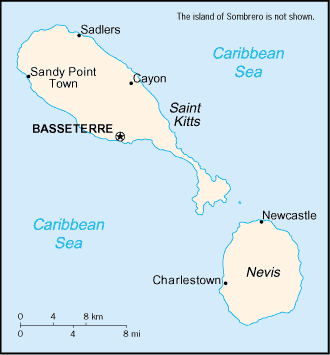
[edit]
- Capital
- Basseterre
- Government
- Constitutional monarchy
- Nationality
- Kittitian, Nevisian
- Population
- 38,950
- Languages
- English
- Religions
- Christianity (Protestant, Catholic)
- Currency
- East Caribbean Dollar (XCD)
- Calling Code
- +1869
- Time Zone
- UTC-4
Contributors
 Utrecht (88%)
Utrecht (88%)
from https://utrecht.travellerspoint.com
Saint Kitts and Nevis Travel Helpers

ambiz
Ask ambiz a question about Saint Kitts and NevisAmicia is a native of St Kitts and Neviswho publishes a website about St Kitts and Nevis at http://www.discover-stkitts-nevis-beaches.com. As a native, Amicia can assist with recommendations for accommodations, entertainment, tours and attractions. She can also provide useful suggestions about buying real estate and doing business in St. Kitts and Nevis.
Accommodation in Saint Kitts and Nevis
Explore your accommodation options in Saint Kitts and Nevis
Community Activity
This is version 43. Last edited at 9:31 on May 8, 19 by Utrecht. 21 articles link to this page.

Except where otherwise noted, content of this article is licensed under a Creative Commons Attribution-ShareAlike 3.0 License

